
Norway - Metro of Oslo
For a full scale picture, please click on the picture shown !
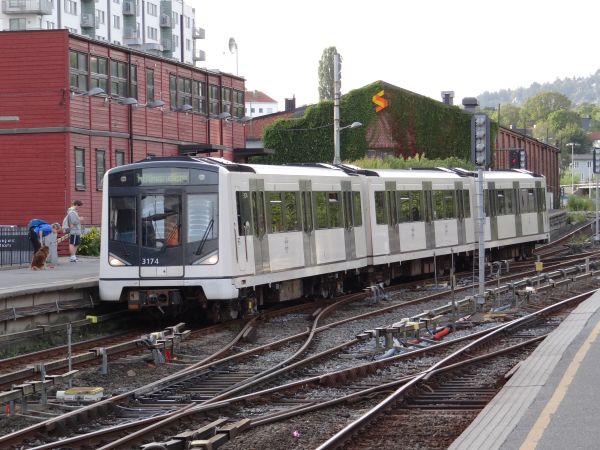
The metro system of Oslo, also called T-bane or Tunnelbane, is the largest
in the Nordic countries. Total length of the lines is 85 km. It has 101 stations, out of which 17 are underground.
The oldest part is the Holmenkollen line, which was a light rail of its own, climbing from the Majorstuen station
close to the city center up the very steep hills to the world famous ski jumping center of Holmenkollen and further to
Frognerseteren, well over 500 m over sea level.
All the metro trains today are of the type MX3000 shown in this first picture.
Older trains were red and there were different trains for different purposes, as for example the Holmenkollen line
was electrified with an overhead catenary, whereas the traditional metro lines had a third rail system and only a few
trains could use both systems. Today even the Holmenkollen line has been modified to a metro type third rail system.
Our first picture is from Majorstuen and the train in the picture has just arrived from the very steep Holmenkollen
line downhill and will now continue as a normal metro under the city center itself.
Picture from Majorstuen 9.9.2015 by Ilkka Siissalo

Inside view of the currently used MX3000 type trains. The gentlemen in front are IT directors from Finland visiting Oslo.
Picture by Ilkka Siissalo 9.9.2015.
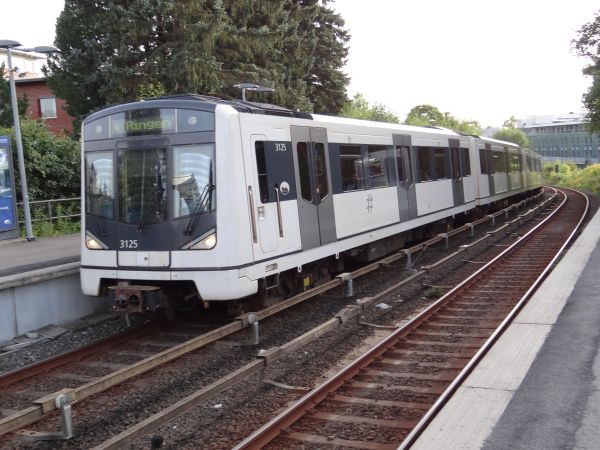
Another one of the current metro trains of the class MX3000, this time on the ring line by the Oslo university campus
at Blindern.
Photo 9.9.2015 by Ilkka Siissalo.
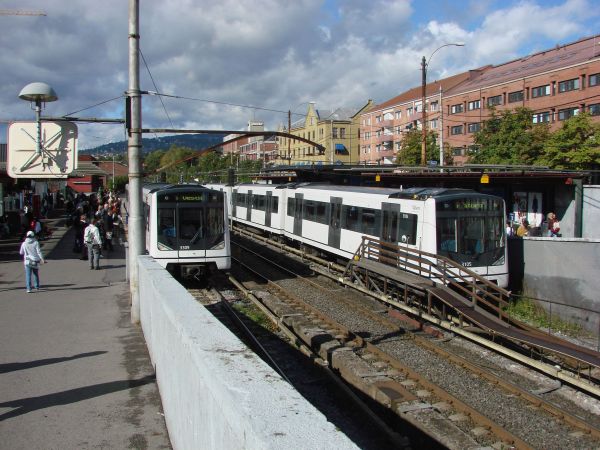
The current class MX3000 trains were really brand new in 2007.
Photo at Majorstuen station 14.9.2007 by Ilkka Siissalo.
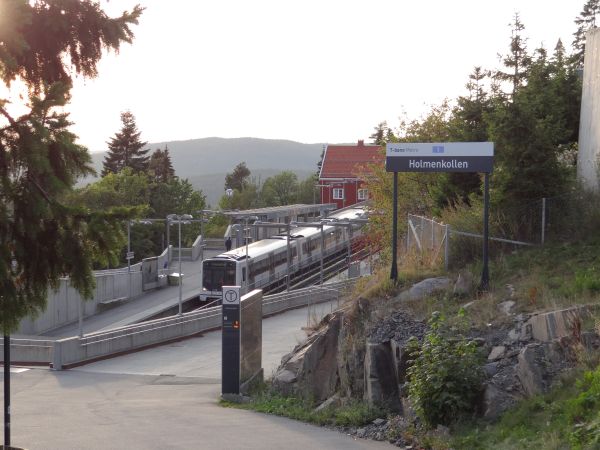
The totally renewed metro station of Holmenkollen skiing center, together with a class MX3000 metro train.
Picture from Holmenkollen 9.9.2015 by Ilkka Siissalo.
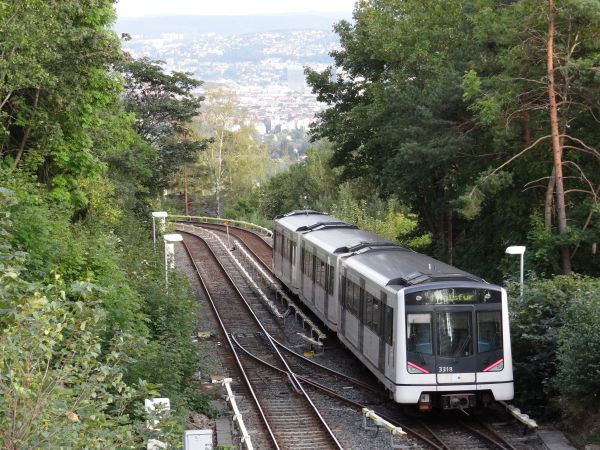
Same train as in the picture above. The Holmenkollen line is extremely steep for normal adhesion type trains.
Picture from Holmenkollen 9.9.2015 by Ilkka Siissalo.
Older metro trains shown in old pictures
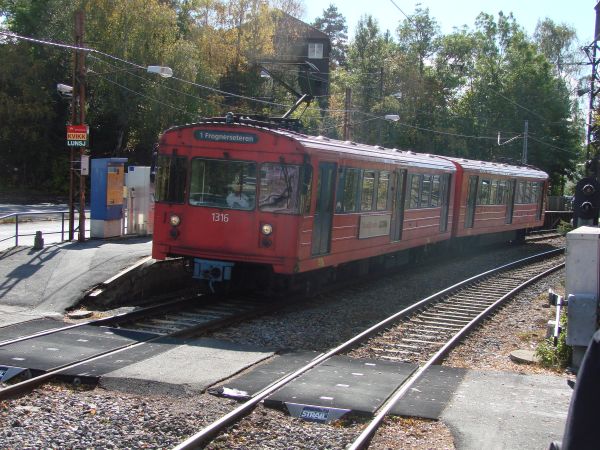
A view from those times when the Holmenkollen line was still a light rail with a catenary wire. This is a class 1300 unit with
dual electric systems, climbing uphill to Holmenkollen and Frognerseteren.
Picture from Blindern 14.9.2007 by Ilkka Siissalo.
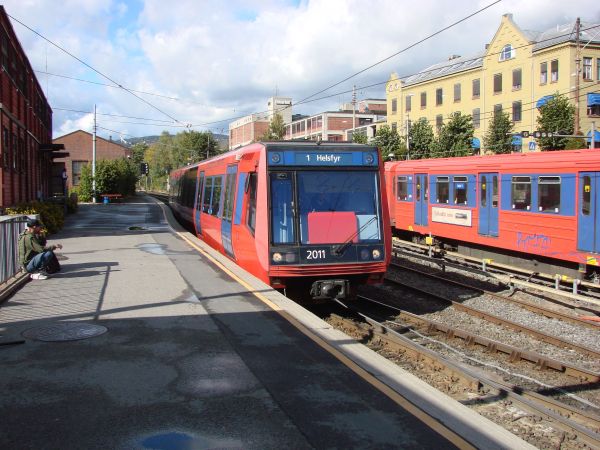
A class T2000 unit has just arrived from the Holmenkollen line in 2007. It has already lowered its pantograph on the roof and
is here using third rail power metro style. In the background an even older train on line 5. All these trains are long gone
by now.
Picture from Majorstuen 14.9.2007 by Ilkka Siissalo.

The point where the metro style third rail ended and the overhead catenary wire began at the beginning of the Holmenkollen line,
seen through the drivers' door window of a class T2000 unit. This is all history by now.
Picture from Majorstuen 14.9.2007 by Ilkka Siissalo.

The cab of a class T2000 unit as they were used in 2007.
Picture from Majorstuen 14.9.2007 by Ilkka Siissalo.

This kind of wooden motorwagons used to operate on the Majorstuen to Holmenkollen line still in the 1980s. The stylish wagon was
made out of expensive but durable teakwood. This unit no 605
was built in 1951 (Sic! It really looks even older, doesn't it?). The last ones of this class were scrapped as late as only in
1995. This one has ended really far from home. Here it is seen as a clubhouse of a company located close to the Amersfoort
station in the Netherlands.
Picture from Amersfoort 6.7.2010 by Ilkka Siissalo.
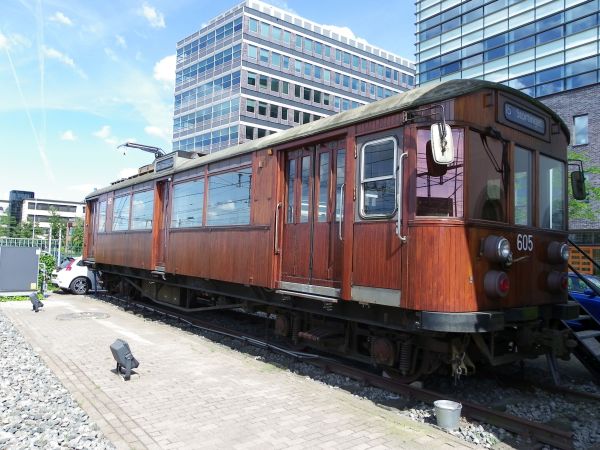
The same old Holmenkollenbanen motor wagon seen from the other side.
Picture from Amersfoort NL 6.7.2010 by Ilkka Siissalo.
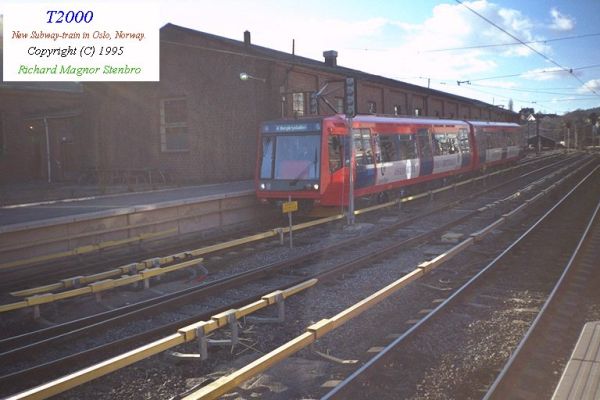
Previous generation metro trains of the class T2000. Photo by Richard Magnor Stenbro © 1995
Uploaded Sep 24, 1995.
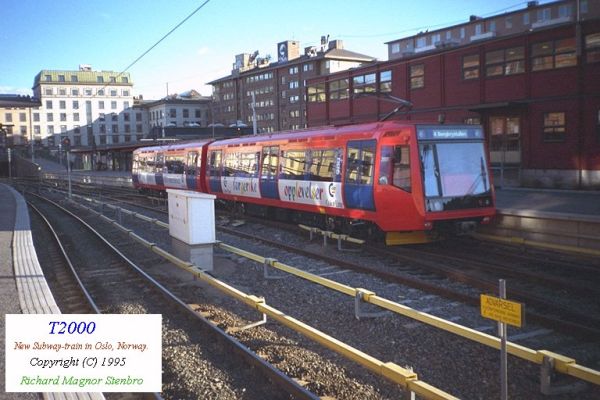
A class T2000 train at Majorstuen in 1995. Photo by Richard Magnor Stenbro © 1995.
Uploaded Sep 24, 1995.
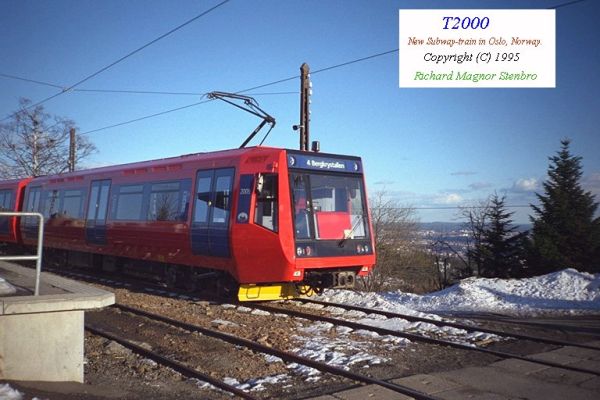
A class T2000 train at Frognerseteren in 1995. These trains had both the overhead pantographs as well as metro's
third rail electric systems and they changed their use of electric system at the Majorstuen station.
Photo by Richard Magnor Stenbro © 1995.
Uploaded Sep 24, 1995.

A class T2000 train at Frognerseteren in 1995.
Photo by Richard Magnor Stenbro © 1995.
Uploaded Sep 24, 1995.

A class T2000 train at Frognerseteren in 1995.
Photo by Richard Magnor Stenbro © 1995.
Uploaded Sep 24, 1995.
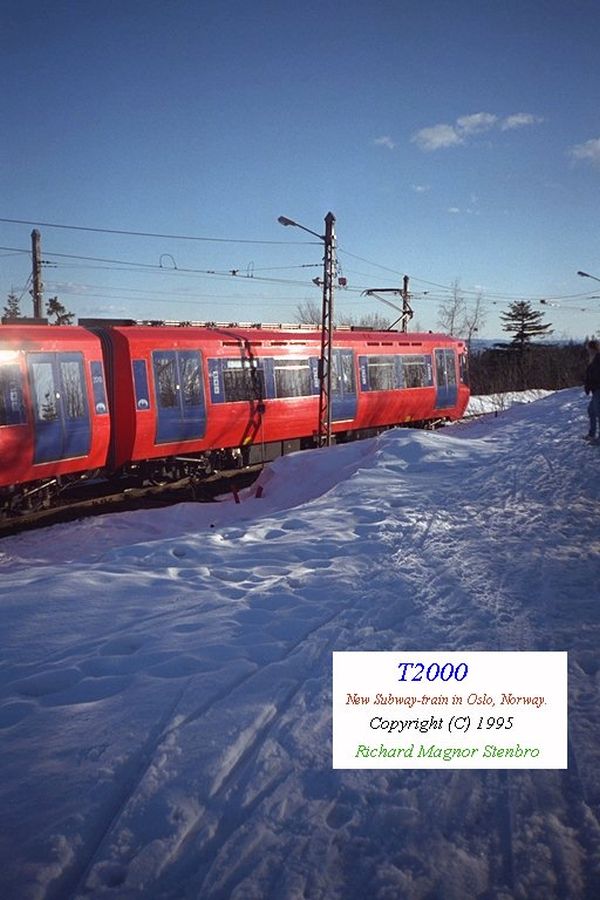
A class T2000 train at Frognerseteren in 1995.
Photo by Richard Magnor Stenbro © 1995.
Uploaded Sep 24, 1995.

A class T2000 train at Frognerseteren in 1995.
Photo by Richard Magnor Stenbro © 1995.
Uploaded Sep 24, 1995.
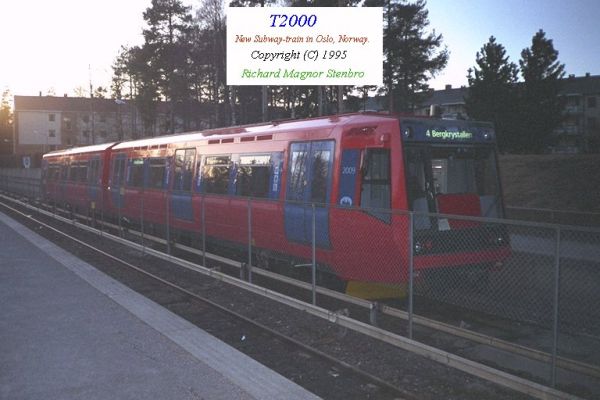
A class T2000 train at Bergkrystallen in 1995.
Photo by Richard Magnor Stenbro © 1995.
Uploaded Sep 24, 1995.

A class T2000 train at Bergkrystallen in 1995.
Photo by Richard Magnor Stenbro © 1995.
Uploaded Sep 24, 1995.
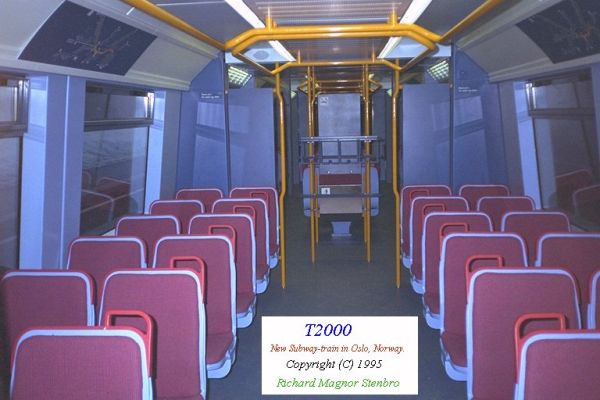
Inside of a class T2000 train in 1995.
Photo by Richard Magnor Stenbro © 1995.
Uploaded Sep 24, 1995.
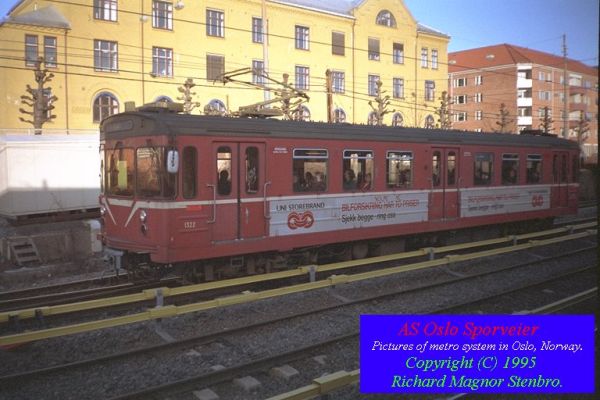
A class 1300 metrocar with overhead power and third rail power support for use on both systems.
Catenary was used only on two small parts of the metro system in 1995:
Line 1 from Frøen station to Frognerseteren station.
Line 4 from Montebello station to Kolsøs station outside the city of Oslo.
There were 49 trains of this type, built in 1976-1981.
Photo by Richard Magnor Stenbro © 1995.
Uploaded Oct 14, 1995.

Majorstuen station seen in direction west.
Line 5. Metro train heading east. There were 146 of this type built in
1964-1976, using only third rail power, 2-6 metro coaches per train.
Length: 17 m. Width: 3,3 m. Weight: 30 tons. Max speed: 70 km/h.
Could not be used on parts of line 1 and 4.
Photo by Richard Magnor Stenbro © 1995.
Uploaded Oct 14, 1995.

This was the the line 1. in 1995 with overhead power only (left) and line 3 and 5 with
third rail power only. This was at Frøen station near Blindern, University of Oslo.
Photo by Richard Magnor Stenbro © 1995.
Uploaded Oct 14, 1995.

Old train on line 3 from Blindern station to Majorstuen station in 1995.
Photo by Richard Magnor Stenbro © 1995.
Uploaded Oct 14, 1995.
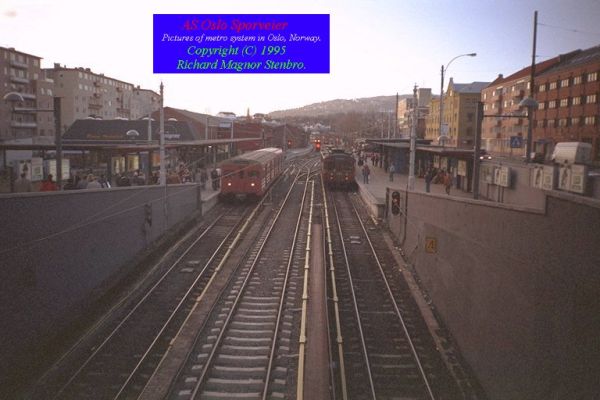
A view from the tunnel under the city centre of Oslo,
at Majorstuen station.
Photo by Richard Magnor Stenbro © 1995.
Uploaded Oct 14, 1995.
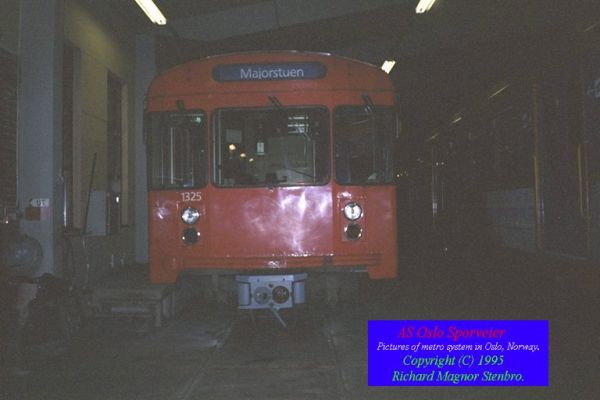
This is a class 1300 type metro train inside the maintance depot at Majorstuen.
Photo by Richard Magnor Stenbro © 1995.
Uploaded Oct 14, 1995.
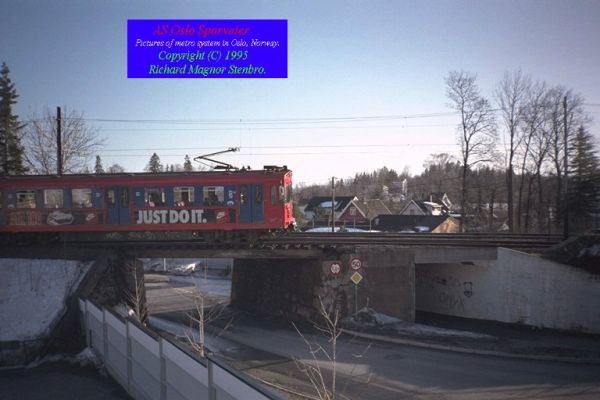
Haslum station on line 4 outside the city of Oslo in 1995.
Photo by Richard Magnor Stenbro © 1995.
Uploaded Oct 14, 1995.
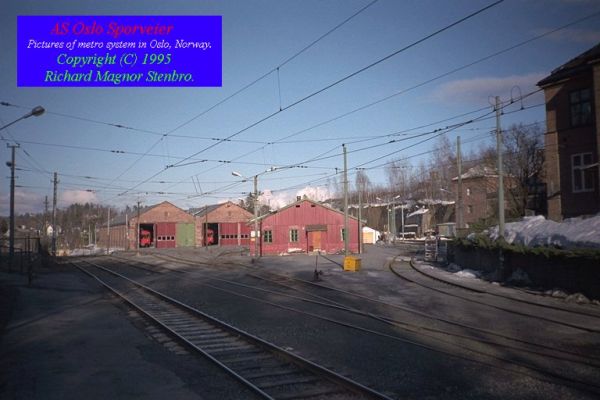
Avløs maintance depot for metrotrains and trams outside Oslo in 1995.
Metro line 4 and tram line 10.
Photo by Richard Magnor Stenbro © 1995.
Uploaded Oct 14, 1995.

This was the traffic control centre at Tøyen station in 1995. From here
the metro system was operated by computers and 2-3 people.
Photo by Richard Magnor Stenbro © 1995.
Uploaded Oct 14, 1995.
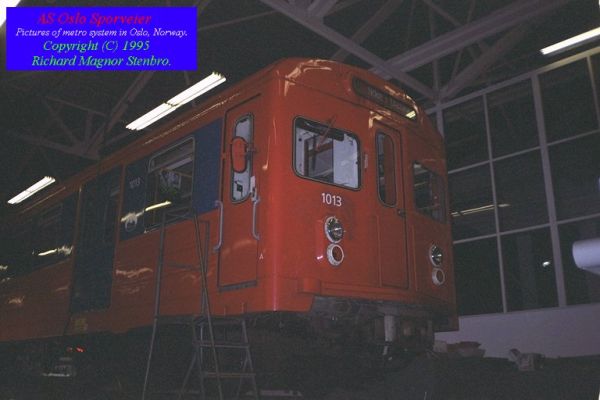
Ryen maintance depot in 1995.
Photo by Richard Magnor Stenbro © 1995.
Uploaded Oct 14, 1995.

Class T2000 control system under construction in unit no. 2001. There were once 12 trains of this type.
Photo by Richard Magnor Stenbro © 1995.
Uploaded Oct 14, 1995.
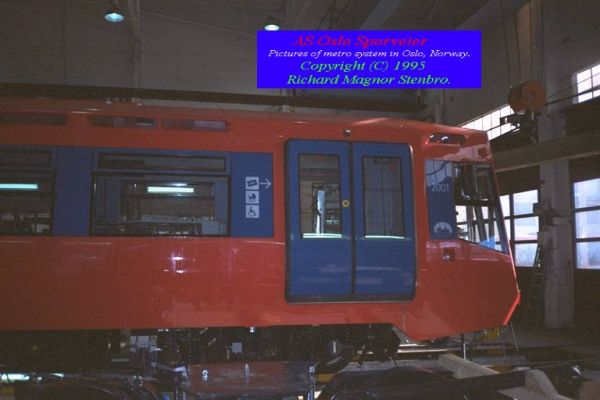
A now scrapped class T2000 unit under construction at factory in 1994.
Photo by Richard Magnor Stenbro © 1995.
Uploaded Oct 14, 1995.

A now scrapped class T2000 unit under construction at factory in 1994.
Photo by Richard Magnor Stenbro © 1995.
Uploaded Oct 14, 1995.

